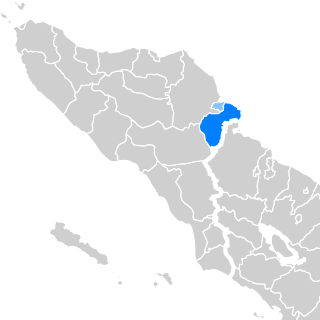| Tamiang Malay | |
|---|---|
| bahase Temiang بهاس تامينڬ | |
| Pronunciation | ba.ha.se teˈmi.aŋ |
| Native to | Indonesia (Aceh) |
| Region | Aceh Tamiang and Langsa |
| Ethnicity | Tamiang Malays |
Native speakers | (136,270 cited 1981 estimate)[1] |
Austronesian
| |
| Dialects |
|
| Latin (Indonesian alphabet) Jawi | |
| Official status | |
Recognised minority language in | |
| Language codes | |
| ISO 639-3 | – |
| Glottolog | None |
 Areas where Tamiang Malay is spoken by the majority of the population
Areas where Tamiang Malay is spoken by a significant minority of the population | |
Tamiang Malay (bahase Temiang, Jawi: بهاس تامينڬ), is a Malayic language spoken in Indonesia, specifically in the Aceh Tamiang and significant minorities in Langsa on southeastern Aceh, bordering North Sumatra. It is primarily spoken by the native Malay people of Tamiang. Tamiang Malay is significantly different from Acehnese, the dominant language in Aceh, and they are mutually unintelligible.[3] Instead, Tamiang Malay shows similarities to Langkat Malay and Deli Malay spoken in neighboring North Sumatra.[4][5] Additionally, Tamiang Malay has been influenced by other languages, such as Acehnese and Gayonese, forming a distinct Malay dialect unique to the region.[6] Tamiang Malay plays a significant role in the daily lives of the Tamiang community. For example, traditional ceremonies, community activities, and other social interactions are conducted in Tamiang Malay. Additionally, for the Tamiang people, Tamiang Malay is considered as a symbol of pride and a distinct regional identity.[5] Most Tamiang people are proficient in Acehnese and Indonesian, in addition to their mother tongue.[7]
The Malays have inhabited Tamiang since the 7th century. Tamiang was once ruled by various pre-Islamic Malay kingdoms and empires, including the Sriwijaya and the Tamiang Kingdom. The increasing influence of the Samudera Pasai Sultanate led to the Islamization of Tamiang in the 14th century.[7] This has resulted in the assimilation of Tamiang culture with other cultures, such as the Acehnese. The continuous arrival of immigrants from other parts of Indonesia has threatened the existence of Tamiang Malay, as its usage has gradually diminished. Many of the current generation of Tamiang Malays is not proficient in Tamiang Malay; instead, they are more comfortable speaking Indonesian.[7]
- ^ Hanafiah et. al. 1986, p. 10.
- ^ Harun, Mohd. (19 December 2017). Bakri (ed.). "Revitalisasi Bahasa Daerah di Aceh". aceh.tribunnews.com (in Indonesian). Banda Aceh, Indonesia: Tribun News. Retrieved 12 July 2024.
- ^ Kompasiana.com (2022-02-03). "Mengenal Asal Mula Suku Tamiang di Aceh Tamiang". KOMPASIANA (in Indonesian). Retrieved 2024-07-11.
- ^ Zulfikar, Muhammad (2020). Pemertahanan Bahasa Tamiang sebagai Identitas Budaya Masyarakat Kuala Simpang (Thesis) (in Indonesian). Langsa: Universitas Samudra.
- ^ a b Toha, Muhammad (2016). "Retensi dan Inovasi Fonologis Protobahasa Melayik pada Bahasa Melayu Tamiang" [Retention and Phonological Innovation of Proto-Melayic in Tamiang Malay]. Ranah: Jurnal Kajian Bahasa (in Indonesian). 5 (1): 90. doi:10.26499/rnh.v5i1.40. ISSN 2579-8111.
- ^ Iqbal, Muhammad (2014). Kerajaan Islam Tamiang di Aceh Abad ke XIV - XVI (Thesis) (in Indonesian). Yogyakarta: Sunan Kalijaga State Islamic University.
- ^ a b c Suryanda, Sigit; Fadlia, Faradilla; Ahmady, Iqbal. (2021). Degradasi Budaya Akibat Asimilasi Pada Masyarakat Melayu Tamiang: Analisis Praktik Sosial Pierre Bourdieu. Journal of Political Sphere, 2(1), 60–80. https://doi.org/10.24815/jps.v2i1.22523